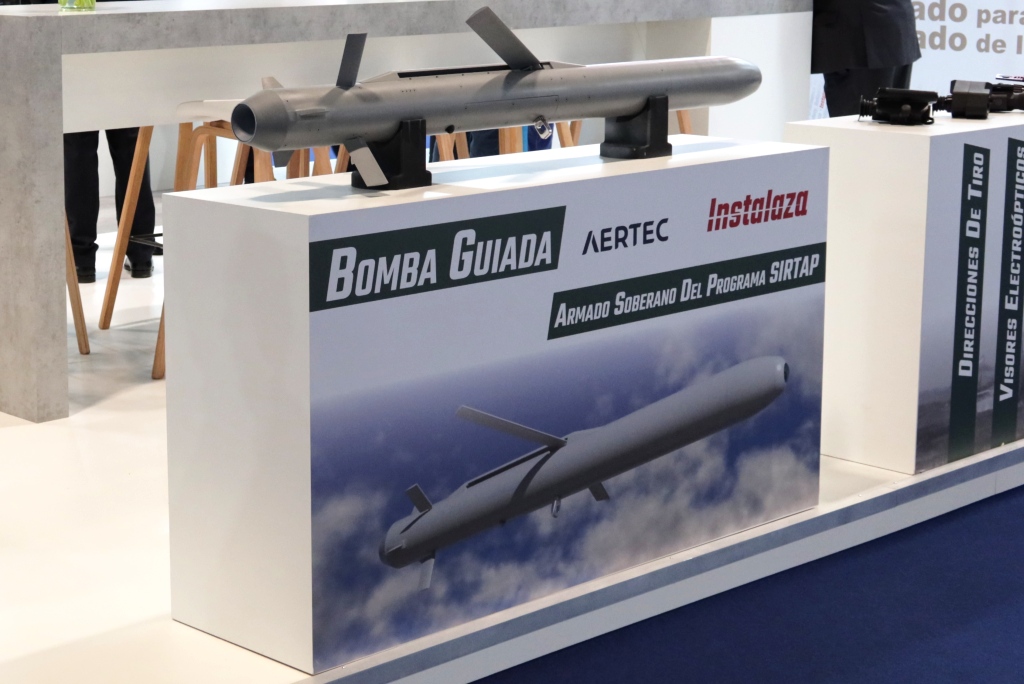
FEINDEF 2025 – Aertec and Instalaza air-launched ordnances for UAVs
At the Madrid exhibition Aertec, a global leader in the aerospace and airport industry, and Instalaza, specialised in warheads and infantry weapons, were showcasing two air-launched ordnances that can be fitted to different classes of unmanned air vehicles (UAVs), the Fox and the BAT
While in the past UAVs weaponisation was considered with scepticism, mostly on moral issues, following recent events that saw the escalation in the lethal use of this type of system, of different sizes and in different forms, this barrier has been overcome, and numerous producers are adding ordnances to airframes once used only for surveillance and intelligence gathering.
Numerous companies started developing weapons sufficiently light and compact to be installed under hardpoints of Class 1 and Class 2 UAVs. In Spain Aertec and Instalaza cooperated in the development of two types of ordnance, the Fox micromissile, aimed at Class 1 systems, and the BAT, a gliding munition aimed at bigger airframes.

The newest product was the BAT, which warhead is provided by Instalaza and is the same used in the Zaragoza-based company Alcotan rocket launcher, which is available in different versions; AT, anti-tank warhead with tandem shaped charge, BIV dual purpose munition with anti-armour plus fragmentation, ABK tandem anti-bunker and MP multi-purpose capable to operate in impact, impact delay and airburst modes. This has a diameter of 100 mm, that dimension leading the design of the bomb which body diameter is marginally bigger. In the nose the lens of the SAL (Semi-Automatic Laser) guidance system is visible. This is the same adopted in the Fox micromissile, and is used only in the terminal guidance phase; it has a ±17° field of view and picks up the laser beam generated by a surface or airborne illuminator bouncing from the target located at around 3 km. The route is planned inserting waypoints, midcourse navigation being provided by an INS/GNSS system.

The BAT has a mass of 16 kg, has a maximum operational altitude of 25,000 ft, and if dropped at that altitude its range is short of 30 km. At launch the aircraft speed must over 50 knots, flight speed varying between Mach 0.2 and 0.6.
Before launch the BAT wings are folded in the upper part of the fuselage. At launch they open forward, while the rear fins do not fold. The BAT is in the development phase, hence the lack of precise measures, and Aertec awaits a launch customer to complete development. This will mostly depend on Airbus, as the BAT was designed to equip the company SIRTAP tactical UAV.

A mock-up of this airframe was visible at FEINDEF, armed with four BATs, which represent a minimal portion of its payload, the Airbus TUAV being able to carry 200 kg, over a maximum take off mass of 800 kg. The programme was launched in December 2023 with the signature of a contract for the development and the procurement of nine systems by the Spanish MoD, each system being made of four air vehicles and one ground control station, the first flight of the SIRTAP is expected by year end. Beside the weapons, it can carry a dual payload, typically an optronic gimbal and a multi mission radar, and is equipped with a SATCOM system that allows it to fully exploit the over 20-hour endurance. The advance in the UAV programme should also allow the start of the BAT full development.

The Fox micromissile was unveiled at FEINDEF 2023 and has just started qualification trials. Compared to original plans these have been delayed by one year, the two-year qualification contract having been signed recently thus the Fox should become available by 2027. In the past two years the design has been refined, the guidance system remaining the aforementioned SAL that needs an external laser illumination to precisely hit the target, Aertec declaring a 2.5 metres CEP; the current missile is 900 mm long and carries a 500 grams HE/FRAG payload based on the C90 warhead that can deal with soft targets and infantry. The warhead, as well as the rocket motor, are provided by Instalaza. The Fox launch envelope is 0 to 70 knots, the missile flight velocity ranging from Mach 0.2 to Mach 0.7. At FEINDEF 2025 the Fox was visible installed on a Tarsis-W, the weaponised member of the Tarsis family.

Compared to the Tarsis ISTAR the Tarsis-W is bigger, 6.2 versus 5.2 metres wingspan and 4.3 versus 3.8 metres length, has a higher maximum take-off mass, 120 kg versus 95 kg, and a much greater payload, 30 kg versus 12 kg. It can fly higher, 1,800 ft versus 15,000 ft, but for a shorter time, 10 hours versus 12 hours, cruise speed being the same, 100 km/h. The higher payload allows the Tarsis-W to carry four Fox missiles while maintaining the optronic gimbal at the front.
EDR On-Line understood a third member of the Tarsis family is being developed, the Tarsis-HVTOL, where H stand for hybrid and VTOL obviously for vertical take-off and landing. An internal combustion engine will ensure battery recharging, the latter powering the electric motors driving the propellers. According to information acquired at FEINDEF, it will feature a tilt wing architecture. No information on a timeline were provided.
Photos by P. Valpolini



